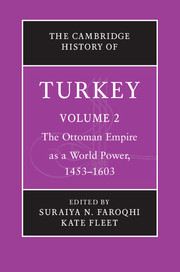Book contents
- Frontmatter
- Contents
- List of Illustrations
- List of Maps
- List of Contributors
- Chronology
- A note on transliteration
- Maps
- 1 Introduction
- Part I An Expanding Empire
- Part II Government, Economic Life and Society
- 7 Government, administration and law
- 8 The Ottoman government and economic life
- 9 Ottoman armies and warfare, 1453–1603
- 10 Religious institutions, policies and lives
- 11 Ottoman population
- Part III Culture and the Arts
- Glossary
- Bibliography
- Index
- References
11 - Ottoman population
from Part II - Government, Economic Life and Society
Published online by Cambridge University Press: 05 July 2013
- Frontmatter
- Contents
- List of Illustrations
- List of Maps
- List of Contributors
- Chronology
- A note on transliteration
- Maps
- 1 Introduction
- Part I An Expanding Empire
- Part II Government, Economic Life and Society
- 7 Government, administration and law
- 8 The Ottoman government and economic life
- 9 Ottoman armies and warfare, 1453–1603
- 10 Religious institutions, policies and lives
- 11 Ottoman population
- Part III Culture and the Arts
- Glossary
- Bibliography
- Index
- References
Summary
In the century and a half covered by this volume, Ottoman governmental structure changed enormously, and so did the society subjected to the rule of the sultans and their office-holders. At the beginning of our period, the empire governed by the sultans extended over the Balkans to include central Anatolia, while the eastern section of the peninsula for the most part was still under the rule of princes recognising as their overlords not the Ottomans but the Mamluk sultans of Egypt and Greater Syria. The latter term refers to the region stretching roughly from the present-day Turkish border to that of Egypt; it encompasses today’s Syria, Lebanon, Israel and Palestine. Mehmed the Conqueror (r. 1451–81) made the Tatar hanate of the Crimea into a dependent principality and the Black Sea into an Ottoman lake. He also began the long, drawn-out project, completed only in 1669 with the conquest of Crete or even in 1715 with the re-conquest of the Peloponnese after a short Venetian occupation, of driving Venice out of the eastern Mediterranean. But for the time being the Venetians and to a lesser extent the Genoese were still very present in the region. While there survive very few official counts recording the empire’s taxpayers of that early period, we can assume that Mehmed II ruled over a population that was Christian to a very large extent.
But by 1603, when our period ended, the Ottoman polity had turned from a regional empire into a world one, and the religious composition of the population had dramatically changed as well. The crucial step was the conquest of the Mamluk sultanate in 1516–17, followed by the annexation of the Hijaz, which made the Ottoman sultans the acknowledged protectors of the pilgrimage to Mecca. There followed the – albeit temporary – acquisition of Yemen and the more durable conquest of Iraq. By the 1530s, the sea captains of Sultan Süleyman I (r. 1520–66) challenged the Portuguese in the Indian Ocean, and while they did not succeed in driving their opponents out of Goa or Hormuz, they did ensure Ottoman control over the Red Sea and thereby the security of Mecca and Medina.
- Type
- Chapter
- Information
- The Cambridge History of Turkey , pp. 356 - 404Publisher: Cambridge University PressPrint publication year: 2012



